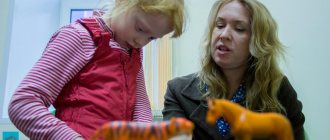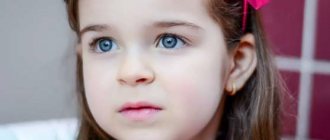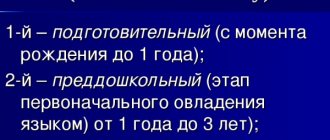Speech is divided into expressive (active) and impressive (passive). Normally, children master two types of it; it is the understanding of oral or written speech that is the passive form and precedes the emergence of active communication.
For example, with deafness it is present and is based on receiving information using the organ of vision. Blind people acquire written receptive language through tactile sensations. Impressive speech in children can be oral and written.
Speech activity consists of the perception of the sound composition of a word, its grammatical form, understanding of intonation and other means of language. It begins with the difference between someone else's and your own speech. This process occurs with the help of phonemic hearing. It is important to be able to distinguish between sounds, both hard and soft; apart from others and with continuous pronunciation. The formation of phonemic hearing ends completely at 4.5-5.5 years. Otherwise, we are talking about developmental delay.
What is expressive speech
The term means a verbal form, expressed out loud, colored emotionally. In children, this ability is formed as a result of imitating the actions of adults: first an idea arises, then an internal statement, and then voicing.
The auditory analyzer and Wernicke's area are responsible for understanding written and oral speech, correct perception of sound signals, and word formation.
In early childhood, it is necessary to encourage and stimulate children's desire to speak without adapting to slurred pronunciation.
Social adaptation with the development of emotional intelligence occurs through regular verbal contacts, so it is useful for a child to listen to the clear diction of adults and practice independently.
Types of speech activity (expressive and impressive speech).
Speech is a specifically human mental function, which can be defined as the process of communication through language.
Speech is a product of long cultural and historical development. Forming in a child as he masters language, speech goes through several stages of development, turning into an expanded system of means of communication and mediation of various mental processes.
Highlight:
Expressive speech (the process of utterance using language) - begins with an idea (program of utterance), then goes through the stage of internal speech, which has a compressed character, and passes into the stage of an expanded external speech utterance (in the form of oral speech or writing).
Impressive speech (the process of understanding a speech utterance (oral or written)) - begins with the perception of a speech message (auditory or visual), then goes through the stage of decoding the message (i.e., highlighting informative moments) and ends with the formation of a general semantic scheme of the message in inner speech, its correlation with semantic semantic structures and inclusion in a certain semantic context (understanding itself). From the point of view of linguistics, the following units can be distinguished in speech:
a) phonemes (meaningful speech sounds);
b) lexemes (words or phraseological phrases denoting individual objects or phenomena);
c) semantic units (generalizations in the form of a system of words denoting concepts);
d) sentences (denoting a certain thought of a combination of words);
e) statements (complete messages).
Inner speech has a different psychological structure, characterized by greater condensation, predicativeness and inaccessibility to direct observation.
We can distinguish four independent forms of speech activity, two of which relate to expressive speech, namely: oral and written speech, and two to impressive speech: understanding oral speech and understanding written speech (reading). Each of the listed forms of speech activity includes several speech functions:
· oral speech can be: active (monologue or dialogic speech) or repeated;
· naming (of objects, actions, etc.) can also be identified as an independent speech function.
· written speech can be independent or under dictation - and then these are different speech functions that have different psychological structures.
The speech system is a whole set of speech functions combined into a single whole.
All these forms of speech represent a complex but unified functional system (or rather, a supersystem), which has many characteristics that distinguish it from other functional systems. The complexity of this system is primarily due to the fact that each of the four subsystems included in it has a certain autonomy and different periods of formation in ontogenesis.
The basic patterns of understanding oral speech and oral speech utterance are formed already at the earliest stages of ontogenesis (up to two or three years), the formation of other forms of speech activity - reading and writing associated with the acquisition of literacy - occurs later and is built according to other psychological laws.
28. Speech impairment due to local brain lesions. Classification of aphasias according to A.R. Luria.
Aphasia is a disorder of already formed speech that occurs due to local lesions of the cortex and “immediate subcortex” of the left hemisphere (in right-handed people) and represents systemic disorders of various forms of speech activity. Aphasia manifests itself in the form of violations of the phonemic, morphological and syntactic structure of one’s own speech and the understanding of addressed speech, while the movements of the speech apparatus, ensuring articulate pronunciation, and elementary forms of hearing are preserved. Aphasia should be distinguished from other speech disorders that occur with brain lesions:
dysarthria (pronunciation disorders without disturbances in the perception of oral speech, reading and writing);
anomia (difficulty naming stimuli of a certain modality due to disruption of interhemispheric interaction);
alalia (speech disorders in childhood in the form of underdevelopment of all forms of speech activity);
motor speech disorders associated with damage to subcortical motor mechanisms;
mutism (speech disorders associated with mental disorders), etc.
In accordance with the classification of A. R. Luria, based on the theory of systemic dynamic localization of higher mental functions, there are 7 forms of aphasia, each of them is associated with a violation of one of the factors on which the speech system is based, and is observed with a certain localization of the pathological process.
Expressive language disorder
With this disease, articulation is poorly developed, there is no clear understanding of how to use the speech apparatus to create sounds, all types of speech activity suffer.
At first, normal learning of new words may be observed, but then progress stops, and the ability to adequately combine grammatical means disappears.
The interest in learning and intelligence of children with motor alalia are usually not impaired, and their practical abilities are fully developed.
Therefore, the first concern for parents is the child’s silence when he understands the situation and reacts logically to verbal communication.
Sometimes, when making a diagnosis, it is necessary to exclude concomitant diseases - improper development of the articulation apparatus is sometimes combined with structural changes in brain tissue.
Then the EEG records epileptiform activity or slowed-down functioning of areas of the brain that regulate the muscles of the vocal apparatus - Wernicke's and Broca's centers.
What Causes Expressive Language Disorder?
The brain organization of 3-year-old children has a well-formed motor speech center; if during this period the child has experienced emotional trauma or been ill, the assimilation of lexical forms and structures may deteriorate.
There are no precisely formulated causes of the disease in information sources, but several factors contribute to its occurrence:
- genetic conditioning, severe stress experienced in the first trimester of pregnancy;
- birth hypoxia, skull injuries sometimes during childbirth;
- encephalitis, meningitis, other dangerous infectious and inflammatory diseases;
- intoxication with alcohol, toxic substances that are released during the combustion of toxic waste - man-made disasters.
An unfavorable social environment, hypovitaminosis of B vitamins, and lack of dialogue have a negative impact on mental and speech development.
Therefore, the organization of comprehensive care plays an important role during the period of restoration of the functions of the speech apparatus.
Symptoms of Expressive Language Disorder
Unlike other disorders, alaliks have the physiological conditions for correct articulation, but they distort and confuse sounds without distinguishing them.
Also, children may suffer from impressive speech - understanding a read text or someone else's statement out loud. Frequent signs of an identified problem:
- bright or reduced expressive coloring of simplified statements, replacement of words with gestures, facial expressions or individual sounds;
- increased salivation;
- poor understanding of the relationship between objects and people’s actions;
- silence during play, silent crying;
- attention deficit disorder, increased motor activity;
- abbreviation, distortion of words to make them easier to pronounce;
- reluctance to track a moving object with the eyes, and search for the source of sound by ear;
- lack of expressiveness of sounds, confusion in the retelling of events.
In an advanced stage, decreased orientation in the area and impaired perception of the relationship of objects in space may be observed.
However, spontaneous resolution of the problem without significant intervention is periodically observed when children are sent to kindergarten.
In the group, their active communication was encouraged and was the key to achieving personal needs.
Article:
Speech is a form of communication that has developed in the process of human activity and is mediated by language.
Speech is the result of coordinated activity of many areas of the brain. The organs of articulation only carry out orders coming from the brain. Sensory (impressive) speech is the perception and understanding of speech. In 1874, E. Wernicke established that there is a sensory speech zone in the cerebral cortex. It was called Wernicke's area. Damage to the superior temporal gyrus leads to the fact that a person hears words, but does not understand their meaning, since in Wernicke’s area, as in a kind of card index, all the words learned by a person are stored, more precisely, their sound images, and he uses this “card index” all his life " If this zone is damaged, then the sound images of words stored there disintegrate, and the person ceases to understand the words. With normal hearing, he remains deaf to words.
There is also motor (expressive) speech - the pronunciation of speech sounds by the person himself. In 1861 French neurosurgeon P. Broca discovered that when the brain is damaged in the area of the second and third frontal gyrus, a person loses the ability to articulate speech; he makes only incoherent sounds, although he retains the ability to understand what others are saying. This speech motor area, or Broca's area, is located in the left hemisphere of the brain in right-handers, and in most cases in the right hemisphere of left-handers. All work on the formation of motor and speech programs occurs in Broca's area. Therefore, when this zone is damaged, a person can only make inarticulate sounds, and is unable to connect them into words.
Much work on drawing up a “map” of the speech zones of the brain was carried out by the Canadian neurosurgeon W. Penfield. In addition to Broca's and Wernicke's areas, Penfield discovered an additional (superior) speech area that plays a supporting role. He managed to reveal the close relationship of all three speech areas, which act as a single speech area. When one of the speech zones of the cortex was removed from a patient, the speech disturbances that arose after some time became smaller, although they did not completely disappear. Consequently, the preserved speech areas performed the functions of the deleted area to some extent. It is in the compensatory capabilities of the brain that the principle of reliability in ensuring speech activity, which is extremely important in human life, is manifested. The speech areas differ in this respect from many other cortical areas. For example, if part of the cortex of the visual or auditory areas is removed, then the impaired functions cannot be restored.
In the process of observations, W. Penfield and his collaborators G. Jasper and L. Robertson identified the unequal role of speech zones. The timing and degree of speech restoration after removal of a particular speech area shows how great its importance is in the implementation of speech function. It turned out that speech is restored more easily and more fully when the upper speech zone is removed - therefore, it really plays a secondary role. When Broca's area is removed, speech impairment is significant and persistent, but speech can still be restored. When Wernicke's area is removed, especially if the subcortical structures of the brain are affected, the most severe, often irreversible speech disorders occur, which indicates the leading role of speech areas (Broca's and Wernicke's) for the development and preservation of speech: their loss is only partially compensated.
The influence of expressive speech delay on the development of Communication at an early age
Children with late development of independent speech, due to physiological reasons, are not accustomed to thinking logically from childhood. Without speech therapy classes at school age, they will make gross syntactic errors when writing from dictation.
There may also be problems with adequate interpretation of abstract images and concepts, which will make it difficult to build interpersonal relationships.
After the first signs of independent thinking appear, children should stimulate their cognitive interest and constantly expand their vocabulary.
If you have problems with verbal expression, it is recommended to play role-playing games together, learn basic phrases of daily etiquette, so that communication with peers is psychologically comfortable.
Psychological diagnostics of preschool children with expressive speech delay
Comprehensive studies help to exclude deafness and the level of speech development; diagnosis of conditions that require additional therapeutic measures is needed.
Such defects include autism, mental retardation, hyperactivity, depressive, anxious or other mental disorders. The following methods help determine the severity of the problem:
- demonstration of objects with the desire to say their name;
- conducting a dialogue with a transition from easy topics to more complex ones to assess pronunciation, vocabulary and its quality;
- asking you to tell what action the picture depicts - the ability to compose sentences of varying complexity is revealed;
- assessment of the pronunciation of sound groups bpm, ztss, chshschch, gkh;
- checking understanding of instructions, graded from simple to complex: touch your nose, point with a pencil at the open window.
Typically, expressive language disorder in children becomes noticeable when the vocabulary and mode of communication are not age-appropriate.
Considering that defects are more amenable to correction in the initial stages, independent attempts to correct the problem can be harmful.
An informative indicator of good development is the finger pointing gesture; if it does not appear by 1.5 years, you should be examined by a pediatric neurologist.
ABOUT THE PROBLEM OF IMPRESSIVE SPEECH IN CHILDREN
T. G. Wiesel
Institute of Defectology and Medical Psychology, Moscow.
Altai State Pedagogical University, Barnaul, Russia.
The problem of speechlessness in children, including impressive speechlessness, has been discussed in the literature for a long time. Despite this, the space of existing descriptions leaves room for the introduction of new approaches that complement theoretical concepts and specific diagnostic and didactic tasks.
The advent of modern neuroimaging technology has made it obvious that early focal brain lesions are not the cause of speech underdevelopment. Previous ideas about the analogy of the brain mechanisms of the development of aphasia turned out to be completely outdated, and the new ones that replaced them remain debatable.
In this work, we bring to your attention the neuropsychological author's concept of the patterns of development of auditory perception of speech and its types in children. It is based on our own previous research, as well as on data available in the field of modern neuroscience. According to them, the main role in the speech development of children should be played by interzonal pathways: a) association pathways, connecting individual areas of the cortex within just one hemisphere and b) commissural pathways, connecting the hemispheres. Specifically, we are talking about the timing of their myelination.
Stages of development of the impressive side of speech
At stage I of speech development, the dominant role belongs to physical hearing (PHH).
At stage II, the brain mechanisms of acquisition of non-speech hearing (NSHL) play a dominant role. This type of auditory perception is necessary for the acquisition of speech-auditory gnosis (RhSlGn-1), which is relevant at stage III, since it is from non-speech noise that useful acoustic features are extracted, which serve as the basis for mastering speech sounds.
The ability to distinguish speech sounds requires the implementation of processes of left hemisphere lateralization, and this is possible only under the condition of normative connections between the hemispheres. Failure to comply with this condition leads to the absence of onomatopoeia in expressive speech. At stage IV, the ability to discretely perceive the sound composition of a word is developed. When interzonal connections at this level are immature, the child does not understand words due to the inability to hear them. The presence of conditional speech auditory agnosia-2 (RhSlAgn-2) is recorded. If not overcome in a timely manner, such agnosia also leads to speechlessness. The final stage of auditory perception of speech (stage V) demonstrates the highest level of speech support, namely phonemic (linguistic). It develops the ability to understand meaningful words denoting objects in the surrounding world. This requires the participation of the highest in the hierarchy of the tertiary temporal cortex of the left hemisphere. The functions of the brain areas that perceive and process objects in the external world are integrated (fit into) the speech mechanism of word understanding.
As a result of interzonal interactions and integration of their functional roles, transitional areas of the brain are specialized at each stage of speech development, designed to operate speech skills that are integrative in structure and at the same time economical in the way of brain implementation. Thanks to them, fluent spoken speech (both impressive and expressive) becomes possible.
Types of impressive speechlessness Speechlessness at stage I appears as a direct consequence of deafness or severe hearing loss. At stage II, non-speech auditory agnosia (NrchSlAgn) may occur. At stage III, manifestations of speech auditory agnosia-1 (RhSlAng-1), that is, the inability to distinguish sounds, are likely. At stage IV, complications such as speech auditory agnosia-2 (RhSlAng-2), causing the inability to fully perceive the sound composition of a word by ear, are likely. At stage V, a dysfunction of the speech perception function may be detected, conventionally designated here as cacaphonemia (aFn), consisting in the inability to recode speech sounds into phonemes and, accordingly, in a lack of understanding of words. This type of impairment of auditory perception of speech is known as sensory alalia.
Correction of speechlessness The content of correctional education for speechlessness is determined by compliance with the principle formulated by L. S. Vygotsky: development proceeds from the bottom up, and decay - from the top down.
Corrective training begins from the stage at which problems are detected. Direct and bypass methods of work are used. They include a wide range of external supports, covering different modalities. The most effective is the optical-tactile method, not only for correcting sound pronunciation, but for building all the ways to bypass speechlessness based on sensory integration techniques.
Methods of treatment and correction
Progress from classes with a speech pathologist depends on the degree of dysfunction and what types of child’s speech skills are most in need of correction - reading, speaking or writing. Clear pronunciation of meaningful phrases may develop by age 3–4 years if the disorder is diagnosed at age 1–2 years.
The main task of correctional therapy is to develop correct speech stereotypes and stimulate word creation. Measures that help coherently express thoughts out loud adapt the child in a social environment:
- Speech gymnastics, costophrenic breathing training. Learning how to coordinate breathing movements with the simultaneous pronunciation of sounds.
- Increasing the efficiency of fine motor skills of the fingers: coloring, playing with a constructor.
- Creating a favorable emotional background, eliminating and preventing negative stressful experiences.
- Acquiring and consolidating the skills of analyzing events and objects - drawing up visual, spatio-temporal characteristics.
- Training of short-term and long-term memory, development of concentration, drawing up chains of cause-and-effect relationships.
The development of expressive speech occurs with the systematic replenishment of vocabulary with the introduction of learned words into dialogue, the formation of complete statements.
Visible results are obtained by a polysensory method of conducting training, awakening the main types of perception: visual, tactile, auditory, gustatory and olfactory.
The task of the adult interlocutor is to find positive emotional triggers that encourage the alalik to actively participate in the dialogue on his own initiative.
Stages of development of a child’s own expressive speech
The period of crying begins with birth; at this time, crying has important diagnostic characteristics, revealing deviations in mental or physical development.
Melodic humming appears by the 5th month, and at the age of 7-8 months, children enter the babbling phase and try to pronounce labial consonants. At 1-1.5 years, there is a stock of 6-8 short words that already have expressiveness, and the process of word creation begins.
The stages of development are individual for each child, but the absence of pronunciation of elementary phrases at 2.5 years is not considered the norm and consultation with a specialist is required.
The diagnosis is preceded by detailed tests of hearing and the state of the nervous system, supplemented by a detailed interview and outpatient observation during the entire period of corrective classes.
Related posts:
- What is "War and Peace" about? Summary of the novel “War and Peace” by chapters. All answers...
- What is folklore and how to use its forms? Small forms of folklore are successfully used in various types of activities for…
- Logorhythmic classes and correctional means By various means, speech therapy classes contribute to the effective correction of speech in children...
- Interaction with parents of children with ODD Cooperation with parents of children with ODD - many methods are listed…








